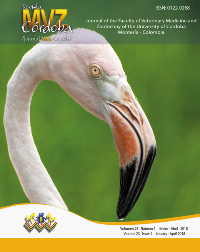Caracterización de mortalidad embrionaria en pollos de engorde
Characterization of embryonic mortality in broilers
Mostrar biografía de los autores
Objetivo. El propósito de este estudio fue caracterizar la incidencia de mortalidad embrionaria (ME) en huevos de estirpes Ross 308 en una empresa de Santander, Colombia. Materiales y métodos. Se realizó un estudio de cohorte prospectivo en el cual se siguieron durante la incubación, por medio de ovoscopía y embriodiagnóstico, 4 grupos de huevos provenientes de reproductoras de 4 edades diferentes. Se reporta el porcentaje de infertilidad, de malformaciones, malposición, huevos fisurados y contaminados. Resultados. La ME general alcanzó 16.08% IC95%(14.69; 17.60) y fue diferente entre los grupos de edad (p<0.001); esta fue mayor para los huevos de reproductoras de 64 semanas con 27.66% IC95% (23.92; 31.99) y menor para las de 47 semanas con 8.84% IC95% (6.97; 11.22). En la primera semana de incubación murió el 57.53% de los embriones y se presentó el pico de muerte entre los días 1 y 3; la segunda semana murió el 38.42%, con un máximo de muertes entre el día 19 y 21. Conclusiones. Este estudio, es el primero de su naturaleza para la zona y la estirpe y permitió confirmar el comportamiento bifásico de la ME aunque existen variaciones en los picos de mortalidad atribuidas posiblemente a las diferencias de las condiciones de producción propias de las empresas.
Visitas del artículo 2041 | Visitas PDF
Descargas
- Romanoff AL. Critical periods and causes of death in avian embryonic development. The Auk 1949; 66(3):264–270. https://doi.org/10.2307/4080357
- Jassim EW, Grossman M, Koops WJ, Luykx RAJ. Multiphasic analysis of embryonic mortality in chickens. Poult Sci 1996; 75(4):464–471. https://doi.org/10.3382/ps.0750464
- Liptói K, Hidas A. Investigation of possible genetic background of early embryonic mortality in poultry. Worlds Poult Sci J 2006; 62(2):326–337. https://doi.org/10.1079/WPS2005101
- Yassin H, Velthuis AGJ, Boerjan M, van Riel J, Huirne RBM. Field study on broiler eggs hatchability. Poult Sci 2008; 87(11):2408–2417.
- Ulmer-Franco AM, Fasenko GM, O'Dea Christopher EE. Hatching egg characteristics, chick quality, and broiler performance at 2 breeder flock ages and from 3 egg weights. Poult Sci 2010; 89(12):2735–2742. https://doi.org/10.3382/ps.2009-00403
- Yahav S, Brake J. Chick embryogenesis: a unique platform to study the effects of environmental factors on embryo development. J Stem Cells 2014; 9(1):17–37.
- Hamburger V, Hamilton H. Appendix II: Normal table of Hamburger and Hamilton (1951; 1992). In: Bellairs R, Osmond M (eds.). Atlas of Chick Development. 3th edition. United Kingdom: Elsevier Academic Press, 2014; 603-621.
- Payne LF. Distribution of mortality during the period of incubation. Poult Sci 1919; s2-6(2):9–12.
- Kuurman W, Bailey B, Koops W, Grossman M. A model for failure of a chicken embryo to survive incubation. Poult Sci 2003; 82(2):214–222. https://doi.org/10.1093/ps/82.2.214
- Scott TA, Mackenzie CJ. Incidence and classification of early embryonic mortality in broiler breeder chickens. Br Poult Sci 1993; 34(3):459–470. https://doi.org/10.1080/00071669308417601
- Bellairs R, Osmond M. Endocrine glands. In: Bellairs R, Osmond M (eds.). Atlas of Chick Development. 3th edition. United Kingdom: Elsevier Academic Press, 2014; 111-113. https://doi.org/10.1016/B978-0-12-384951-9.00012-5
- Elibol O, Brake J. Effect of flock age, cessation of egg turning, and turning frequency through the second week of incubation on hatchability of broiler hatching eggs. Poult Sci 2006; 85(8):1498–1501.
- Lourens A, Molenaar R, van den Brand H, Heetkamp MJW, Meijerhof R, Kemp B. Effect of egg size on heat production and the transition of energy from egg to hatchling. Poult Sci 2006; 85(4):770–776. https://doi.org/10.1093/ps/85.4.770
- Fasenko GM. Egg storage and the embryo. Poult Sci 2007; 86(5):1020–1024. https://doi.org/10.1093/ps/86.5.1020
- Khabisi MM, Salahi A, Mousavi SN. The influence of egg shell crack types on hatchability and chick quality. Turk J Vet Anim Sci 2012; 36(3):289-295.
- Almeida J, Vieira S, Reis R, Berres J, Barros R, Ferreira A, et al. Hatching distribution and embryo mortality of eggs laid by broiler breeders of different ages. Rev Bras Cienc Avic 2008; 10(2):89–96. https://doi.org/10.1590/S1516-635X2008000200003
- Solomon SE. The eggshell: strength, structure and function. Br Poult Sci 2010; 51(sup1):52–59.
- Gualhanone A, Furlan R, Fernandez-Alarcon M, Macari M. Effect of breeder age on eggshell thickness, surface temperature, hatchability and chick weigh. Rev Bras Cienc Avic 2012; 14(1):09-14. https://doi.org/10.1590/S1516-635X2012000100002
- McDaniel GR, Roland DA, Coleman MA. The effect of egg shell quality on hatchability and embryonic mortality. Poult Sci 1979; 58(1):10–13. https://doi.org/10.3382/ps.0580010
- El-Hanoun AM, Rizk RE, Shahein EHA, Hassan NS, Brake J, T. BD, et al. Effect of incubation humidity and flock age on hatchability traits and posthatch growth in Pekin ducks. Poult Sci 2012; 91(9):2390–2397. https://doi.org/10.3382/ps.2011-02075
- Schmidt G, Figueiredo E, Saatkamp M, Bomm E. Effect of storage period and egg weight on embryo development and incubation results. Rev Bras Cienc Avic 2009; 11(1):1–5. https://doi.org/10.1590/S1516-635X2009000100001
- Mortola JP, Al Awam K. Growth of the chicken embryo: Implications of egg size. Comp Biochem Physiol Part A Mol Integr Physiol 2010; 156(4):373–379. https://doi.org/10.1016/j.cbpa.2010.03.011
- Elibol O, Brake J. Effect of egg weight and position relative to incubator fan on broiler hatchability and chick quality. Poult Sci 2008; 87(9):1913–1918. https://doi.org/10.3382/ps.2008-00014
- Gabrielli MG, Accili D. The chick chorioallantoic membrane: a model of molecular, structural, and functional adaptation to transepithelial ion transport and barrier function during embryonic development. J Biomed Biotechnol 2010; 2010. DOI: 10.1155/2010/940741 https://doi.org/10.1155/2010/940741
- Reijrink IAM, Meijerhof R, Kemp B, Van Den Brand H, Arora KL, Kosin IL, et al. The chicken embryo and its micro environment during egg storage and early incubation. Worlds Poult Sci J 2008; 64(04):581–598. https://doi.org/10.1017/S0043933908000214
- Zakaria AH, Plumstead PW, Romero-Sanchez H, Leksrisompong N, Brake J, A. FN, et al. The effects of oviposition time on egg weight loss during storage and incubation, fertility, and hatchability of broiler hatching eggs. Poult Sci 2009; 88(12):2712–2717. https://doi.org/10.3382/ps.2009-00069
- Herring G, Ackerman JT, Eagles-Smith CA. Embryo malposition as a potential mechanism for mercury-induced hatching failure in bird eggs. Environ Toxicol Chem 2010; 29(8):1788-1794. https://doi.org/10.1002/etc.208
























